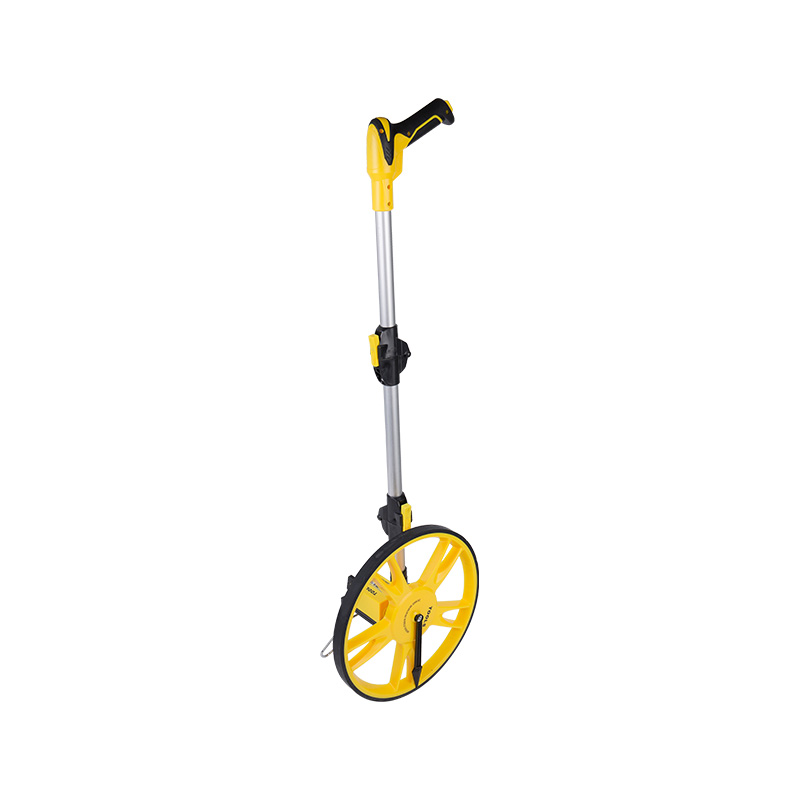Users of measuring wheels may encounter several common errors or challenges during measurements. Here are some of these issues and how they can be mitigated:
1.Obstacles and Irregular Terrain:
Challenge: Measuring wheels are susceptible to inaccuracies when encountering obstacles or uneven terrain, as the wheel may bounce or skip over obstacles.
Mitigation: Clear the measurement path of debris and obstacles whenever possible. Utilize measuring wheels with larger, pneumatic or solid wheels that can better handle rough terrain and minimize wheel bounce.
2.Wheel Slippage:
Challenge: Adverse weather conditions, such as rain or snow, can result in measuring wheel slippage on slick surfaces, leading to measurement discrepancies.
Mitigation: Invest in measuring wheels designed with anti-slip features like rubber or spiked wheels to enhance traction. Ensure the measuring wheel's wheel surface is clean and dry before use.
3.Inaccurate Calibration:
Challenge: Over time, measuring wheels may drift from their calibrated settings, resulting in measurement errors.
Mitigation: Implement a routine calibration schedule in adherence to the manufacturer's guidelines. Retire or repair measuring wheels with worn components or damage to maintain precision.
4.Inconsistent Rolling Speed:
Challenge: Variations in the rolling speed of the measuring wheel can affect measurement accuracy.
Mitigation: Encourage users to maintain a consistent rolling speed by using wheels equipped with a built-in speed indicator. Regular practice to develop a steady rhythm can also enhance accuracy.
5.Curved or Non-Straight Paths:
Challenge: Measuring wheels are primarily intended for straight-line measurements; deviations from a straight path can result in inaccuracies.
Mitigation: When confronted with curved paths, break them down into shorter, straight segments and sum the measurements to maintain accuracy.
6.Wheel Size and Units of Measurement:
Challenge: Differences in wheel size and units of measurement between measuring wheels can lead to calculation errors.
Mitigation: Ensure awareness of the wheel size and units being employed. Employ suitable conversion factors or tools to guarantee uniformity when converting measurements.
7.User Fatigue:
Challenge: Extended usage of measuring wheels can lead to user fatigue, potentially diminishing precision.
Mitigation: Incorporate breaks during prolonged measurement sessions to alleviate fatigue. Consider using measuring wheels equipped with ergonomic handles and features designed for comfortable extended use.
8.Environmental Factors:
Challenge: Environmental conditions like wind, extreme temperatures, and humidity can impact measuring wheel accuracy.
Mitigation: Whenever possible, measure in favorable weather conditions. For critical measurements, explore supplementary equipment or technologies like laser rangefinders, which are less affected by environmental factors.
9.Recording Errors:
Challenge: Incorrectly recording measurements during or after measurement can result in data entry errors.
Mitigation: Implement a double-check procedure for measurements as they are recorded. Consider utilizing digital measuring wheels with built-in data logging to minimize recording errors and enhance data integrity.
10.Lack of Proper Training:
Challenge: Inadequate familiarity with measuring wheel operation and techniques among users can lead to inaccuracies.
Mitigation: Provide comprehensive training to users regarding the proper utilization of measuring wheels, encompassing calibration and maintenance procedures, to ensure proficiency and precision in measurement tasks.
Item: No.JN27-H
Wheel diameter: 31.8cm
Material: ABS

 [email protected] / [email protected]
[email protected] / [email protected]
 +86-571-81993095
+86-571-81993095

